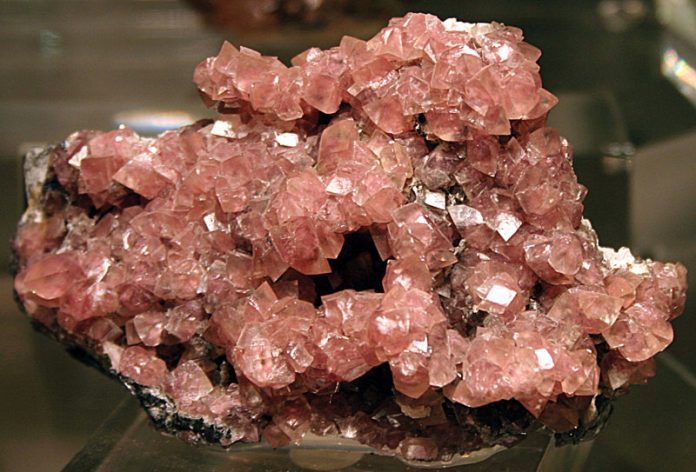
Calamine is often thought of in summer when we grab some lotion to treat itchy skin, but there’s more to this mineral than a brightly colored bottle from the pharmacy.
Calamine Through History
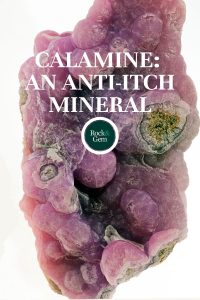
The earliest copper-zinc alloy calamine brass showed up about 10,000 years ago at the end of the Stone Age.
That is when ancient peoples first discovered that by heating certain rocks they yielded a metal, likely copper from malachite. The Egyptians used powdered malachite to color their pottery. When the pottery was fired in excess, malachite produced tiny beads of copper metal.
The discovery of copper introduced the Chalcolithic Age which quickly became the Bronze age as folks figured out that by mixing copper with arsenic or tin minerals they could produce bronze. Early metalsmiths gradually learned to regulate and vary the process to get the properties they wanted in bronze. They also knew that by combining copper with calamine they produced brass but they still knew little about calamine.
Calamine was used by the Chinese, the Greeks and the Romans. None of these civilizations had seen the metal element zinc, yet they knew calamine was the source of the metal. By combining calamine with copper they produced a golden and useful metal called calamine brass.
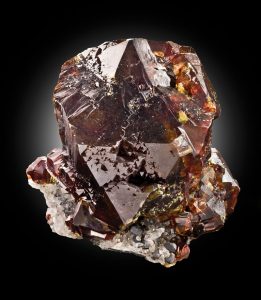
Courtesy of Arkenstone
Making Brass
In the early days of mining and metallurgy, even scientists had never recovered zinc metal as a native element or in the laboratory. This is because smelting calamine ore produced the pure metal but as soon as zinc was not combined with something it disappeared!
Making brass was a hit-or-miss effort and we had to wait thousands of years after brass first appeared before we figured out calamine was two zinc minerals. The funny thing is they were producing pure zinc but didn’t realize it.
By putting zinc ore with copper and heating it, the zinc would vaporize and slowly infuse into the copper to form brass. Brass was not formed by combining two molten metals so much as infusing one metal, zinc, into the liquid metal copper. They soon figured out they could control the amount of zinc in the copper-zinc alloy by controlling the temperature and time of the process. This way they could produce brass with different properties for different uses.
Disappearing Act
Zinc is a metal element but when its minerals are smelted the zinc has a nasty habit of vaporizing. Zinc has one of the lowest melting points of the metal elements, under 1000°C. It also has the odd property at high temperatures that if it is uncombined with another element, it immediately goes to the gas phase. No wonder the early metal workers didn’t find zinc in their furnaces.
As a consequence, pure zinc remained a mystery until the 1500s when a scientist searching for zinc in the laboratory realized the powdery material clinging to the ceiling of his lab was the missing zinc metal. It had vaporized, risen to the ceiling, cooled and sublimated from a gas to a solid.
Fluorescent Minerals
What makes minerals fluorescent? Today collectors can buy evidence of zinc’s odd properties. Fluorescent mineral collectors are familiar with the bright green crystalline, spiky-looking zinc oxide crystals that fluoresce brilliantly. This is collected from the chimney flues of zinc smelters where zinc gas cools, combines with oxygen on the interior of the flue and crystallizes.
The Full Picture
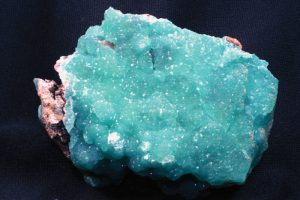
Courtesy of Jones Collection
It was in 1803 that calamine was completely analyzed by James Smithson. He discovered calamine was two common zinc minerals intimately mixed; smithsonite, a zinc carbonate and hemimorphite, a zinc silicate.
Smithson is best known as the founding donor of the Smithsonian Institution.
These two common zinc minerals are found intimately mixed because both are derived from the zinc sulfide sphalerite under the same conditions.
Though calamine is now a discredited name it is still used in the mining and metal industry. It still confuses collectors because the two minerals look so much alike. Both are found in the same upper oxide zones of zinc deposits where released zinc atoms are chemically active and will readily combine with what is available.
In a carbonate environment, it will combine with carbonate radicals to form smithsonite. If silicate ions are handy, zinc atoms form hemimorphite.
Similar Appearances
In appearance, both these minerals form massive often botryoidal layers in the same deposit. Both can crystallize but the vast majority of both minerals are found in massive undulating layers. They can also be alike in color ranging from white to green if iron is present and blue when copper is present.
As discrete crystals, they are markedly different in developing in differing crystal systems. Smithsonite is hexagonal and can be trigonal, dogtooth, simple hexagons or rhombic crystals having slightly curving faces. Hemimorphite crystals are orthorhombic and crystallize most often as slender prismatic crystals seldom more than an inch or two long.
Hemimorphite is named for its crystal form composed of the word parts Hemi and morph. Hemi means half. Morph means to change from one form to another. This is just what hemimorphite crystals do as one termination of the crystal develops a flat prism face while the opposite termination has several pyramidal faces.
Without accurate chemistry, these zinc minerals were identified by their physical properties, like hardness, which is not accurate. It was almost impossible to identify these two specimens when found together as calamine. This is why the name calamine was so useful before modern chemistry.
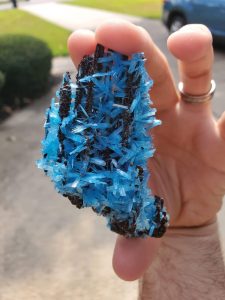
Courtesy of Unique Minerals
Mining Smithsonite
A great deal has been written about smithsonite for several reasons, it is more common than hemimorphite and its crystallized specimens are more attractive, being more colorful than hemimorphite and forming in a variety of crystal shapes.
In this country, the now-famous Kelly mine, near Socorro, New Mexico, made smithsonite popular as it produced large quantities of fine blue massive smithsonite in large curving specimens that are extremely handsome. In the early days, huge pieces of blue smithsonite were so abundant large masses were used as grave markers when a miner was killed on the job.
Along the border between Belgium and Germany, huge deposits of calamine, not unlike the large smithsonite slabs found at the Kelly mine, were worked 200 years ago.
One Belgian village, Kelmis (La Calamine) near the mines was named for the mineral.
Germany’s source of calamine was around the Beirgerburg area. Calamine has been mined in many other places for its zinc content including Franklin, New Jersey.
Mining Hemimorphite
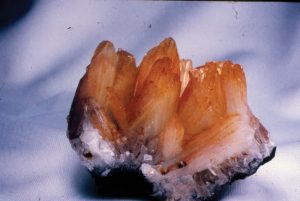
Courtesy of Unique Minerals
Hemimorphite is not as common or as attractive as smithsonite, but fine crystals are abundant in Mexico in the Santa Eulalia mining area and especially at Mina Ojuela, Mapimi and Durango.
Crystals from these mines are found typically on the reddish-brown iron oxide gossan material that forms when a metallic deposit is exposed to weathering which creates an upper oxide zone relatively easy to mine. In the desert, oxide zones can reach over 1000 feet in depth. This is important as such deep weathering creates far more opportunities for secondary minerals like smithsonite and hemimorphite to form and be found together.
Mexican hemimorphite crystals are clear, colorless to snow white. The crystals are lustrous and the more pleasing crystals have acquired a slight hue caused by included reddish iron oxide, which is often more concentrated at the tips of crystals. No other natural color is seen in Mexican hemimorphite crystals though you may see specimens of bright blue hemimorphite which are dyed and are not natural.
Crystallized hemimorphite forms in tight clusters of slightly diverging blades or as free-standing individual crystals that form all over the curving iron oxide matrix.
Specimens from both Mapimi, Durango and Santa Eulalia Chihuahua look very much alike and have been available at reasonable prices for decades.
Fake Hemimorphite
Aside from the iron oxide coloring, Mexican hemimorphite was never found naturally with a bright color until 2020, when blue hemimorphite was mined at Mapimi in large quantities. This was exciting as a normally very nice collector mineral of modest color and value was suddenly found in very showy brightly colored specimens of high value. Dealers rushed to stock up on this new and exciting find. But many dealers were also suspicious and properly so.
Within a few months of their appearance on the market, the Mexican blue hemimorphite was proven scientifically in a lab to have been dyed. The crystals were natural colorless hemimorphite specimens but treated with a synthetic blue dye to make them more attractive and valuable.
The sellers even had a movie supposedly showing the blue specimens being mined underground. This was done to attempt to pass them off as natural! Many dealers and customers had been, in the words of the British, diddled! It’s worse than that as some dealers had invested huge sums buying faked hemimorphite. Dealers who bought these fakes did their best to make it right for customers but the damage was done. These faked specimens will be with us forever, so buyer beware.
This story about calamine appeared in Rock & Gem magazine. Click here to subscribe. Story by Bob Jones.















